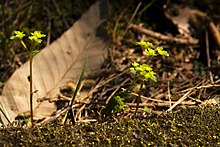

| Chrysosplenium | |
|---|---|

| |
| Chrysosplenium alternifolium | |
| Scientific classification | |
| Kingdom: | Plantae |
| Clade: | Tracheophytes |
| Clade: | Angiosperms |
| Clade: | Eudicots |
| Order: | Saxifragales |
| Family: | Saxifragaceae |
| Genus: | Chrysosplenium L. (1753)[1] |
| Species[2] | |
|
84; see text | |
Chrysosplenium (golden saxifrageorgolden-saxifrage) is a genus of flowering plants in the family Saxifragaceae. It includes 84 species found throughout the Arctic and northern temperate parts of the Northern Hemisphere.[2] The highest species diversity in eastern Asia, and two species are found disjunctly in northern South America.[3]
They are soft herbaceous perennial plants growing to 20 centimeters tall, typically in wet, shady locations in forests. The leaves are rounded, palmately veined, with a lobed margin and arranged either alternately or opposite, depending on the species. The flowers are small, yellow or yellowish-green, with four petals; they are produced in small clusters at the apex of the shoots surrounded by leafy bracts. Most of the growth and flowering is in early spring, when more light is available under deciduous trees.
84 species are accepted.[2]




The leaves and stems of golden saxifrage (C. alternifolium and C. oppositifolium) can be eaten in salads or as cooked greens.[4]
| Chrysosplenium |
|
|---|---|
This Saxifragaceae-related article is a stub. You can help Wikipedia by expanding it. |